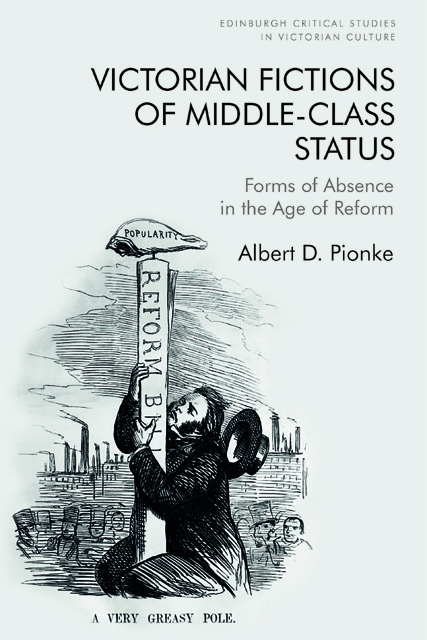Book contents
- Frontmatter
- Contents
- Acknowledgements
- Introduction: Victorian Middle-Class Status and the Negative Assertion of Value
- 1 The Orphan Narratives of a Class Lacking Antecedents
- 2 Repudiations of Wealth in Victorian Financial Fiction
- 3 The Violence at the Heart of the Social Problem Novel
- 4 Social Domination, Social Scientific Empiricism, and Novelistic Distrust of the Modern Fact
- 5 Legitimizing the Subjection of Middle-Class Women in Mid-Victorian Fiction
- Afterword
- Bibliography
- Index
Introduction: Victorian Middle-Class Status and the Negative Assertion of Value
Published online by Cambridge University Press: 25 April 2023
- Frontmatter
- Contents
- Acknowledgements
- Introduction: Victorian Middle-Class Status and the Negative Assertion of Value
- 1 The Orphan Narratives of a Class Lacking Antecedents
- 2 Repudiations of Wealth in Victorian Financial Fiction
- 3 The Violence at the Heart of the Social Problem Novel
- 4 Social Domination, Social Scientific Empiricism, and Novelistic Distrust of the Modern Fact
- 5 Legitimizing the Subjection of Middle-Class Women in Mid-Victorian Fiction
- Afterword
- Bibliography
- Index
Summary
Victorian England experienced a crisis over social stratification that might once have been dismissed as mere semantics, but that the affordances of more recent criticism now allow us to recognize as a collision of form. Two overlapping explanations for collective inequality –the first a time-honored subdivision of society into numerous historically if not divinely ordained stations, each dependent upon those above it and responsible to those below, with the borders between them recorded in sumptuary law; and the second a much simpler and more confrontational separation between the privileged and the people intensified by industrialization, post-war economic depression, and Regency-era repressive legislation –were being challenged by a newer model made up of three primary strata. The most problematic element of this recent schema was its intermediate layer, whose overwhelmingly urban members had been increasing rapidly in numbers, wealth, and desire for influence since the 1780s.
Even what to call these social in-betweeners was a matter of some debate, quite literally so during the 1831 session of Parliament. For instance, future historian Thomas Babington Macaulay, speaking in favor of what we now know as the First Reform Bill in his capacity as MP for the doomed pocket borough of Calne, peppered what was certainly one of the most powerful speeches of the session, on 2 March 1831, with three different referents for the same constituency: middle “class”; “middle classes”; and “middle order.” Speaking two days later, Francis Jeffrey advocated in favor of enfranchising “the great number of persons of wealth, respectability, intelligence, and loyalty, belonging to the middle ranks”; and three days after that Lord Dudley Stuart fulsomely praised “the middling classes; the most virtuous, and generally the most influential, in all countries; and particularly the pride and flower of England.” Opponents of reform were similarly uncertain of how to label those whom they wished to remain without a vote, with Sir Robert Peel referring repeatedly to “the middle classes” on 3 March 1831; Colonel Edward Michael Conolly on 24 August 1831 lamenting a foreseeable decline in “the middle orders” as a result of the bill; and the Duke of Wellington, on 10 April 1832, judging the incipient act as “opposed to the sentiments of all the gentlemen, of the yeomanry, and of the middling classes throughout the country.
- Type
- Chapter
- Information
- Victorian Fictions of Middle-Class StatusForms of Absence in the Age of Reform, pp. 1 - 25Publisher: Edinburgh University PressPrint publication year: 2022

